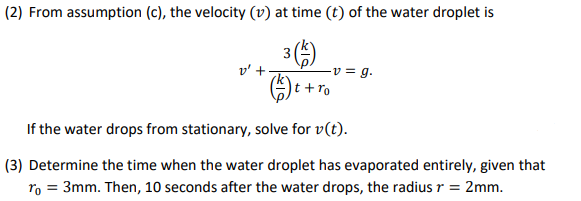(2) From assumption (c), the velocity (v) at time (t) of the water droplet is 3() v' +. -v = g. |t +ro If the water drops from stationary, solve for v(t). (3) Determine the time when the water droplet has evaporated entirely, given that ro = 3mm. Then, 10 seconds after the water drops, the radius r = 2mm. %3D
(2) From assumption (c), the velocity (v) at time (t) of the water droplet is 3() v' +. -v = g. |t +ro If the water drops from stationary, solve for v(t). (3) Determine the time when the water droplet has evaporated entirely, given that ro = 3mm. Then, 10 seconds after the water drops, the radius r = 2mm. %3D
Trigonometry (MindTap Course List)
8th Edition
ISBN:9781305652224
Author:Charles P. McKeague, Mark D. Turner
Publisher:Charles P. McKeague, Mark D. Turner
Chapter3: Radian Measure
Section3.5: Velocities
Problem 61PS: A gear train consists of three gears meshed together (Figure 9). The middle gear is known as an...
Related questions
Question
Differential equation

Transcribed Image Text:(2) From assumption (c), the velocity (v) at time (t) of the water droplet is
3 5)
-v = g.
v' +
t+ro
If the water drops from stationary, solve for v(t).
(3) Determine the time when the water droplet has evaporated entirely, given that
ro = 3mm. Then, 10 seconds after the water drops, the radius r = 2mm.
![A water droplet evaporates before they reach the ground.
Figure 1: Water droplets (source]
In this situation, a few assumptions are made:
a) At initial point, a typical water droplet is in sphere shape with radius r and remain spherical
while evaporating.
b) The rate of evaporation (when it loses mass (m)) is proportional to the surface area, S.
c) There is no air-resistance and downward direction is the positive direction.
To describe this problem, given that p is the mass density of water, rois the radius of water before it
drops, m is the water mass, V is the water volume and k is the constant of proportionality.](/v2/_next/image?url=https%3A%2F%2Fcontent.bartleby.com%2Fqna-images%2Fquestion%2F07a5608b-6d33-4c63-b694-46c9ae7b5e4d%2Fb03f82db-7854-4e2b-9d33-d04328518656%2F0uxqmq_processed.png&w=3840&q=75)
Transcribed Image Text:A water droplet evaporates before they reach the ground.
Figure 1: Water droplets (source]
In this situation, a few assumptions are made:
a) At initial point, a typical water droplet is in sphere shape with radius r and remain spherical
while evaporating.
b) The rate of evaporation (when it loses mass (m)) is proportional to the surface area, S.
c) There is no air-resistance and downward direction is the positive direction.
To describe this problem, given that p is the mass density of water, rois the radius of water before it
drops, m is the water mass, V is the water volume and k is the constant of proportionality.
Expert Solution
This question has been solved!
Explore an expertly crafted, step-by-step solution for a thorough understanding of key concepts.
Step by step
Solved in 3 steps with 3 images

Recommended textbooks for you

Trigonometry (MindTap Course List)
Trigonometry
ISBN:
9781305652224
Author:
Charles P. McKeague, Mark D. Turner
Publisher:
Cengage Learning

Linear Algebra: A Modern Introduction
Algebra
ISBN:
9781285463247
Author:
David Poole
Publisher:
Cengage Learning

Elementary Geometry for College Students
Geometry
ISBN:
9781285195698
Author:
Daniel C. Alexander, Geralyn M. Koeberlein
Publisher:
Cengage Learning

Trigonometry (MindTap Course List)
Trigonometry
ISBN:
9781305652224
Author:
Charles P. McKeague, Mark D. Turner
Publisher:
Cengage Learning

Linear Algebra: A Modern Introduction
Algebra
ISBN:
9781285463247
Author:
David Poole
Publisher:
Cengage Learning

Elementary Geometry for College Students
Geometry
ISBN:
9781285195698
Author:
Daniel C. Alexander, Geralyn M. Koeberlein
Publisher:
Cengage Learning

Elementary Geometry For College Students, 7e
Geometry
ISBN:
9781337614085
Author:
Alexander, Daniel C.; Koeberlein, Geralyn M.
Publisher:
Cengage,

Trigonometry (MindTap Course List)
Trigonometry
ISBN:
9781337278461
Author:
Ron Larson
Publisher:
Cengage Learning